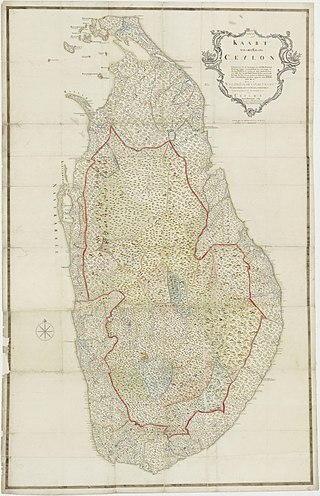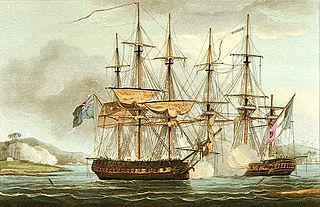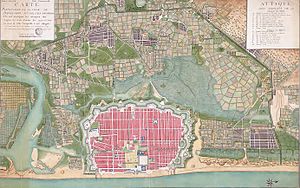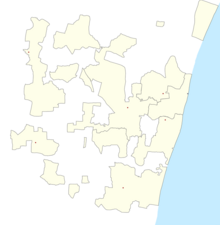
The Mauritius campaign of 1809–1811 was a series of amphibious operations and naval actions fought to determine possession of the French Indian Ocean territories of Isle de France and Île Bonaparte during the Napoleonic Wars. The campaign lasted from the spring of 1809 until the spring of 1811, and saw both the Royal Navy and the French Navy deploy substantial frigate squadrons with the intention of disrupting or protecting trade from British India. In a war in which the Royal Navy was almost universally dominant at sea, the campaign is especially notable for the local superiority enjoyed by the French Navy in the autumn of 1810 following the British disaster at the Battle of Grand Port, the most significant defeat for the Royal Navy in the entire conflict. After their victory, the British used the original Dutch name of Mauritius for Isle de France. In 1814, Île Bonaparte was returned to France, who eventually renamed it La Réunion.

The siege of Madras was a siege of Madras, which was then under British rule, between December 1758 and February 1759 by French forces under the command of Comte de Lally during the Seven Years' War. The British garrison was able to hold out until it was relieved.

The siege of Pondicherry was the first military action on the Indian subcontinent following the declaration of war between Great Britain and France in the American Revolutionary War. A British force besieged the French-controlled port of Pondicherry in August 1778, which capitulated after ten weeks of siege.

HMS Diomede was a 44-gun fifth rate built by James Martin Hillhouse and launched at Bristol on 18 October 1781. She belonged to the Roebuck class of vessels specially built during the American Revolutionary War for service in the shallow American coastal waters. As a two-decker, she had two complete batteries of guns, one on the upper deck and the other on the lower deck.

The Battle of Tellicherry was a naval action fought off the Indian port of Tellicherry between British and French warships on 18 November 1791 during the Third Anglo-Mysore War. Britain and France were not at war at the time of the engagement, but French support for the Kingdom of Mysore in the conflict with the British East India Company had led to Royal Navy patrols stopping and searching French ships sailing for the Mysorean port of Mangalore. When a French convoy from Mahé passed the British port of Tellicherry in November 1791, Commodore William Cornwallis sent a small squadron to intercept the French ships.

The Sunda Strait campaign of January 1794 was a series of manoeuvres and naval actions fought between warships and privateers of the French Republic and a squadron of vessels sent by the British East India Company to protect trade in the region, later augmented by Dutch warships. The campaign developed as French forces based on Île de France reacted more quickly than the British forces in the Indian Ocean to the expansion of the French Revolutionary Wars on 1 February 1793. French privateers rapidly spread along the British trade routes in the Far East, becoming concentrated around the narrow Sunda Strait between the islands of Java and Sumatra in the Dutch East Indies. These ships were soon joined by French Navy frigates and began to inflict losses on shipping in the region. The Royal Navy forces in the Indian Ocean were deployed elsewhere and so the East India Company, the private enterprise that ruled much of British India in the 1790s and maintained their own fleet and navy, raised a squadron of armed merchant ships to patrol the Strait and drive off the raiders.
The action of 5 May 1794 was a minor naval engagement fought in the Indian Ocean during the French Revolutionary Wars. A British squadron had been blockading the French island of Isle de France since early in the year, and early on 5 May discovered two ships approaching their position. As the strange vessels came closer, they were recognised as the French frigate Duguay Trouin, which had been captured from the East India Company the year before, and a small brig. Making use of a favourable wind, the British squadron gave chase to the new arrivals, which fled. The chase was short, as Duguay Trouin was a poor sailor with many of the crew sick and unable to report for duty. The British frigate HMS Orpheus was the first to arrive, and soon completely disabled the French frigate, successfully raking the wallowing ship. After an hour and twenty minutes the French captain surrendered, Captain Henry Newcome of Orpheus taking over the captured ship and bringing his prize back to port in India.

The siege of Calvi was a combined British and Corsican military operation during the Invasion of Corsica in the early stages of the French Revolutionary Wars. The Corsican people had risen up against the French garrison of the island in 1793, and sought support from the British Royal Navy's Mediterranean Fleet under Lord Hood. Hood's fleet was delayed by the Siege of Toulon, but in February 1794 supplied a small expeditionary force which successfully defeated the French garrison of San Fiorenzo and then a larger force which besieged the town of Bastia. The British force, now led by General Charles Stuart, then turned their attention to the fortress of Calvi, the only remaining French-held fortress in Corsica.

The siege of San Fiorenzo was a British military operation, supported by Corsican partisans early in the French Revolutionary Wars against the French-held town of San Fiorenzo on the Mediterranean island of Corsica. The Corsican people had risen up against the French Republican garrison in 1793 after an attempt to arrest the Corsican leader Pasquale Paoli during the Reign of Terror. The French had then been driven into three fortified towns on the northern coast; San Fiorenzo, Calvi, and Bastia and Paoli appealed to the British Royal Navy's Mediterranean Fleet, commanded by Lord Hood, for assistance against the French garrison.

The Invasion of Ceylon was a military campaign fought as a series of amphibious operations between the summer of 1795 and spring of 1796 between the garrison of the Batavian colonies on the Indian Ocean island of Ceylon and a British invasion force sent from British India. The Dutch Republic had been a British ally during the French Revolutionary Wars, but was overrun by the French Republic in the winter of 1794 and reformed into the client state of the Batavian Republic. The British government, working with the exiled Stadtholder William of Orange, ordered the seizure of Batavian assets including colonies of the former Dutch Empire. Among the first territories to be attacked were those on the coast of the island of Ceylon, with operations initially focused on the trading port at Trincomalee.

The Battle of Île Ronde was a minor naval engagement between small French Navy and British Royal Navy squadrons off Île de France, now named Mauritius, in the early stages of the French Revolutionary Wars. The battle was fought over control of the waters around Île de France, which was under blockade from the British squadron as French warships and privateers operating from the island posed a significant threat to vital British trade routes connected to British India and China.

The Battle of Mahé was a minor naval engagement of the last year of the French Revolutionary Wars, fought on 19 August 1801 in the harbour of Mahé in the Seychelles, a French colony in the Indian Ocean. Since the demise of the French Indian Ocean squadron in 1799, the Royal Navy had maintained dominance in the East Indies, controlling the shipping routes along which trade flowed and allowing the rapid movement of military forces around the theatre. French First Consul Napoleon Bonaparte had long-harboured ambitions of threatening British India, and in 1798 had launched an invasion of Egypt as an initial step to achieving this goal. The campaign had failed, and the French army in Egypt was under severe pressure by early 1801, partly due to the presence of a British squadron acting with impunity in the Red Sea.

The East Indies theatre of the French Revolutionary Wars was a series of campaigns related to the major European conflict known as the French Revolutionary Wars, fought between 1793 and 1801 between the new French Republic and its allies and a shifting alliance of rival powers. Although the Indian Ocean was separated by vast distance from the principal theatre of the conflict in Western Europe, it played a significant role due to the economic importance of the region to Great Britain, France's most constant opponent, of its colonies in India and the Far Eastern trade.

The action of 28 February 1799 was a minor naval engagement of the French Revolutionary Wars, fought off the mouth of the Hooghly River in the Bay of Bengal between the French frigate Forte and the Royal Navy frigate HMS Sybille. Forte was an exceptionally large and powerful ship engaged on a commerce raiding operation against British merchant shipping off the port of Calcutta in British India. To eliminate this threat, Sybille was sent from Madras in pursuit. Acting on information from released prisoners, Edward Cooke, captain of Sybille, was sailing off Balasore when distant gunfire alerted him to the presence of Forte on the evening of 28 February. The French frigate was discovered at anchor in the sandbanks at the mouth of the Hooghly with two recently captured British merchant ships.

The action of 9 September 1796 was an inconclusive minor naval engagement between small French Navy and British Royal Navy squadrons off northwestern Sumatra, near Banda Aceh, during the French Revolutionary Wars. The French squadron comprised six frigates engaged in commerce raiding against British trade routes passing through captured parts of the Dutch East Indies, and posed a considerable threat to the weakened British naval forces in the region. The British force consisted of two 74-gun ships of the line hastily paired to oppose the eastward advance of the French squadron.
The action of 9 February 1799 was a minor naval engagement of the French Revolutionary Wars between a British Royal Navy frigate and a French privateer frigate fought 100 nautical miles (190 km) west of the southeastern coast of what is now Natal in South Africa. The 32-gun French frigate Prudente had since the start of the war been part of a squadron operating from Île de France. This squadron had dispersed during 1798, with the ships sent on independent commerce raiding operations across the British trade routes in the Indian Ocean. Prudente had subsequently been seized in the autumn of that year by Anne Joseph Hippolyte de Maurès, Comte de Malartic, the Governor of Île de France, and sold to a private raiding company.

The Battle of Port Louis was a minor naval engagement of the French Revolutionary Wars, fought on 11 December 1799 at the mouth of the Tombeau River near Port Louis on the French Indian Ocean island of Île de France, later known as Mauritius. Preneuse had originally been part of a powerful squadron of six frigates sent to the Indian Ocean in 1796 under the command of Contre-amiral Pierre César Charles de Sercey, but the squadron dispersed in 1798 and by the summer of 1799 Preneuse was the only significant French warship remaining in the region. The battle was the culmination of a three-month raiding cruise by the 40-gun French Navy frigate Preneuse, commanded by Captain Jean-Matthieu-Adrien Lhermitte. Ordered to raid British commerce in the Mozambique Channel, Lhermitte's cruise had been eventful, with an inconclusive encounter with a squadron of small British warships in Algoa Bay on 20 September and an engagement with the 50-gun HMS Jupiter during heavy weather on 9–11 October.

The Invasion of the Cape Colony, also known as the Battle of Muizenberg, was a British military expedition launched in 1795 against the Dutch Cape Colony at the Cape of Good Hope. The Dutch colony at the Cape, established and controlled by the United East India Company in the seventeenth century, was at the time the only viable South African port for ships making the journey from Europe to the European colonies in the East Indies. It therefore held vital strategic importance, although it was otherwise economically insignificant. In the winter of 1794, during the French Revolutionary Wars, French troops entered the Dutch Republic, which was reformed into the Batavian Republic.

The invasion of Corsica was a campaign fought in the spring and summer of 1794 by combined British military and Corsican irregular forces against a French garrison, early in the French Revolutionary Wars. The campaign centred on sieges of three principal towns in Northern Corsica; San Fiorenzo, Bastia and Calvi, which were in turn surrounded, besieged and bombarded until by August 1794 French forces had been driven from the island entirely.

The invasion of the Spice Islands was a military invasion by British forces that took place between February and August 1810 on and around the Dutch owned Maluku Islands also known as the Spice Islands in the Dutch East Indies during the Napoleonic wars.
















